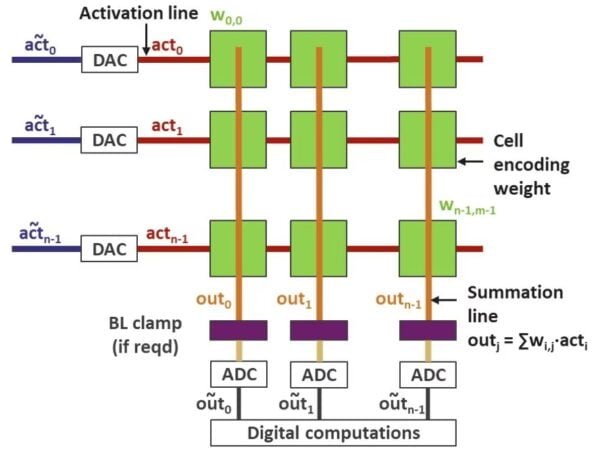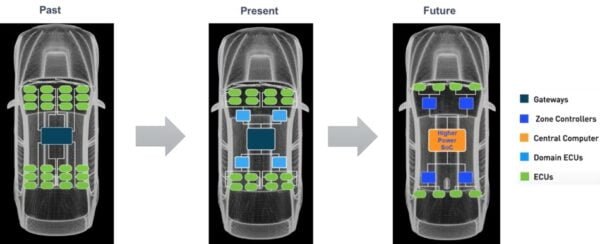You undoubtedly saw the impressive news back in December 2022 that using what is called “inertial confinement”, scientists and engineering teams at the National Ignition Facility (NIF) of Lawrence Livermore National Laboratory (LLNL) achieved fusion “success” by producing more energy than the energy delivered by its 192 lasers converging on a target. The project and its precursors have consumed over 60 years of research and development in lasers, optics, diagnostics, target fabrication, computer modeling and simulation, and experimental design (plus many tens of billions of dollars), Figure 1. Note that the lasers themselves were only about 1% efficient, so the power required was 100× the laser output and the entire arrangement was a huge net-energy loss.

Figure 1 The almost unimaginably complex NIF/LLNL achieved brief fusion energy “gain”—if you ignore the 100× power needed to drive its 192 lasers. Source: NIF/LLNL via typeset.io
This fusion approach is not the only path being explored. There’s a huge European-centric effort called ITER and various smaller-scale approaches using different physics and principles.
Impressive as the LLNL/NIF and other efforts are, there’s another half to the story of “nearly endless, pollution-free power” that so many are touting as viable. That thus-far unanswered question is how do you manage and extract—let’s be flexible and call it “harvest”—this enormous power and transform it into useful electricity?
Engineers are, of course, familiar with the concept and reality of harvesting at various scales and types, whether it is on a small scale such as a piezo-driven transducer, a medium or larger scale photovoltaic farm, or at a large scale via a fossil-fuel megawatt station. Each of these has been used extensively and there are mature techniques supported by components, systems, and structures for each one.
For fusion-based power sources, it’s a different story. On one side there’s the huge laser-driven fusion reactor of the LLNL-NIF project; on the other side, there are no precedents for this type of power conversion. Unlike a conventional boiler where the source heat is used to directly develop high-pressure steam and then drive a turbine and generator (Figure 2), nuclear fusion faces very different steam-creation challenges, even when compared to that “other” nuclear source of fission.

Figure 2 In contrast to a fusion-based source, a conventional oil/coal/gas-fired electric-generating station is conceptually simple, even if an actual installation has industrial complexities. Source: Chegg, Inc.
One approach is somewhat conventional. In the design being pursued by ITER, neutrons will be absorbed by the surrounding walls of their huge tokamak—a fusion-enabling construct which uses a powerful magnetic field to confine plasma in the shape of a torus—where their kinetic energy will be transferred to the walls as heat. The heat will be captured by cooling water circulating in the vessel walls and eventually dispersed through cooling towers, Figure 3.

Figure 3 In contrast to the inertial confinement fusion of the NIF/LLNL approach but with a similar huge size and scope, the European-led ITER project is using the magnetic field surrounding a tokomak to confine the plasma. Source: ITER
In contrast, start-up Commonwealth Fusion Systems (CFS), a spinout of MIT’s Plasma Science and Fusion Center, is developing high-performance tokamak that is much smaller and less expensive than the ITER approach, Figure 4 (note the humans standing nearby for scale).

Figure 4 Smaller start-ups such as Commonwealth Fusion Systems are striving to achieve fusion with much smaller tokamaks and other topologies, in sharp contrast the incredibly enormous NIF/LLNL and ITER projects. Source: Commonwealth Fusion Systems
Their plan for creating the useful steam output is to use a continuously flowing blanket of molten salt. A loop of this salt will be pumped into a tank surrounding the plasma chamber, where it absorbs radiated neutrons. This molten salt is then pumped outside the tokamak, where its heat energy is transferred into a more-conventional fluid that drives a turbine to generate electricity.
Although molten salt is already used in some heat-concentrating, non-photovoltaic solar installations, this molten salt is not ordinary at all. Instead, it will likely be a mixture of lithium fluoride and beryllium fluoride (FLiBe). In this combination, the salt also acts as a “breeding” medium in which some of the fusion neutrons interact with lithium atoms and change them into tritium. The tritium is then filtered out of the blanket and recycled into fusion fuel; a rare hydrogen isotope used to fuel magnetic-confinement reactors.
Helion Energy is going an entirely different way. According to their web site, their device “directly recaptures electricity; it does not use heat to create steam to turn a turbine, nor does it require the immense energy input of cryogenic superconducting magnets. Our technical approach reduces efficiency loss, which is key to our ability to commercialize electricity from fusion at very low costs. The FRC [field reversed configuration] plasmas in our device are high-beta and, due to their internal electrical current, produce their own magnetic field, which pushes on the magnetic field from the coils around the machine.”
It continues, “The FRCs collide in the fusion chamber and are compressed by magnets around the machine. That compression causes the plasma to become denser and hotter, initiating fusion reactions that cause the plasma to expand, resulting in a change in the plasma’s magnetic field. This change in magnetic field interacts with the magnets around the machine, increasing their magnetic field, initiating a flow of newly generated electricity through the coils. This process is explained by Faraday’s Law of Induction.” I’m not going to pass judgement on this, that’s for sure.
The large-scale LLNL-NIF and ITER projects as well as the smaller ones such as at CFS, Helion, and others are literally and figuratively focused on creating a controlled, self-sustaining fusion reaction to produce the power with the hoped-for attributes of being limitless and pollution free. How and when that will happen is anyone’s educated guess, ranging from at least several decades to perhaps—and let’s be brutally honest here—maybe never.
Still, the fusion challenge is only half of the overall problem. The second half is converting the enormous heat energy into electrical energy, and it is still another major project with its own known and unknown technical problems and scaling issues.
All of this complexity makes me wonder how the Sun and other stars do their fusion so easily, without need of all this hardware and organization. Perhaps a truly “out of the box” idea is needed, such as running a very long pipe filled with some suitable phase-change material from Earth towards the Sun and back in a long loop? As they say, “never say never”.
Until then, what’s your view on approaches to transforming the heat energy of a sustained fusion reaction—assuming that day comes—into useable, controllable electricity?
Bill Schweber is an EE who has written three textbooks, hundreds of technical articles, opinion columns, and product features.



